12
THE FAT, THE OLD AND THE BEAUTIFUL
MATERIAL PROCESS AND FRICTIONAL RESISTANCE ON THE BODY OF ARCHITECTURE
NOTE
A shift has seemingly taken place in architecture, from understanding architecture as object towards an understanding of architecture as process. But architecture has always been object, material and process – shaped by context, phenomena, and time. Cockatoo Island in Sydney’s harbour, visited on occasion of the Urban Islands Studio Review, set a mode for rethinking architectural processes, and became a memory search of things abandoned, diluted, lost, or stored away. The island initiated a reflection on aspects of architectural processes that are currently marginalized, such as age, beauty, erosion, material, thickness, and loss of context. This paper pursues these aspects as explorations found in the fabric of Cockatoo Island and its architecture. The aim of the paper is to present a sequence of observations that might reintroduce and amplify tunes temporarily absent - or merely inaudible? - from architectural discussion.
Material processes define the formation of architecture. They drive decisions in selecting material, working techniques, shape, density, texture and structure. The construction process gives sense to a material. Once architecture is built, another series of material processes begins: transformation and deterioration. The material reacts to the site and specific dynamic forces such as currents or climate. Materials maintain a mode of resistance. This resistance occurs as a friction on the surface, as resistance to the concept applied to it; or it might manifest by 140forming a reactive layer, by giving in, fading, or vanishing. A process of becoming is initiated.1 Transience is part of architecture. It may emerge as a physical transformation, as a change in meaning, as dislocation, or as reinterpretation. Aspects of conversion can take many paths.
This paper follows traces in material, becoming ‘other,’ gradual changes of a diverse nature, and frictional resistances. A number of simultaneous processes are discussed by assembling an overlay, contra-post, or superimposition, rather than stringing aspects in a continuous order. It is a reflection on material frictions and phenomena of deterioration, building and unbuilding, numbers and use, order and beauty, displacement and absence. To be contemplated. To be materialized. To be continued.
ISLAND DISLOCATION
Cockatoo has one main point of arrival and departure across the sea. The island is a voyage that leads in a directional sequence through spatial settings that differ from the interwoven, seamless fabric of the city. Isolated and detached from urban structures of multiple layers, the presence of the island’s topography and objects becomes more apparent. Here, time comes to a halt. Detached from its former program, and just before the insertion of the next layer of use, the island may be understood as raw material, abstracted, and tranquil.
Cockatoo is the site of various degrees of dislocation; the removal of architectural objects or substantial parts, the discontinuation of a program, the displacement of mass and material in the topography. A conversion alters the relationship between object and fact. A dislocation influences the permanence of an object. When detached from its context, the object tends to loose part of its meaning. When context changes, character changes, and identity shifts. A programmatic change triggers a crisis of the object, it requires a conversion, and initiates a morphosis. The whole island is the object that is displaced. Such an exposed, stripped-bare territory is in need of a readjustment in context and content. On Cockatoo Island, matter was always a matter of reinterpretation. An absence of program was rapidly equalized, shifting from industrial, maritime, educational 141and legislative appropriation.2 A compression of time can ensure continuity and identity.
The easiest thing is to condense time, logically, by overlapping traces. In the end, you are not working with the physical reality of the moment, but with the physical reality of everything that has been there as well, that has built up a place. Any construction that has been capable of surviving the passage of time is by definition an ongoing transformation.3
ENRIC MIRALLES
Traces and tracing describe what has been there, what is in progress, and what might come. These traces evoke simultaneity of present, past and future. Similar to a Deleuzian fold, strata of time are enfolded in each other. The traces give an indication of potential, actualities and possibilities.4 They forecast strategies for architecture and island, which are embedded in its present and past.
The removal of objects leaves an imprint of a former position on a surface, legible only to someone familiar with former use or meaning (Figure 1). To the inexperienced eye, these traces signify merely forms and shapes; the code becomes enigmatic. Though the signage might appear precise and thus enable a reestablishment of a tool, the working process and technique might get lost together with the instrument and the knowledge of the material.
Part of identity and meaning are lost in the discontinuation of a program. When the object loses its function, it loses its base of existence, unless an alternate use can be found. Sometimes this is not possible. The precision of a mechanical object shaped according to its function leaves no space for a conversion. In Slipway No 2, the machine objects become matter, the material returns to a raw state. The steel elements transmit a beauty of abandonment, a life of their own (Figure 2). Industrial turns mechanimal – a mechanical animal.142
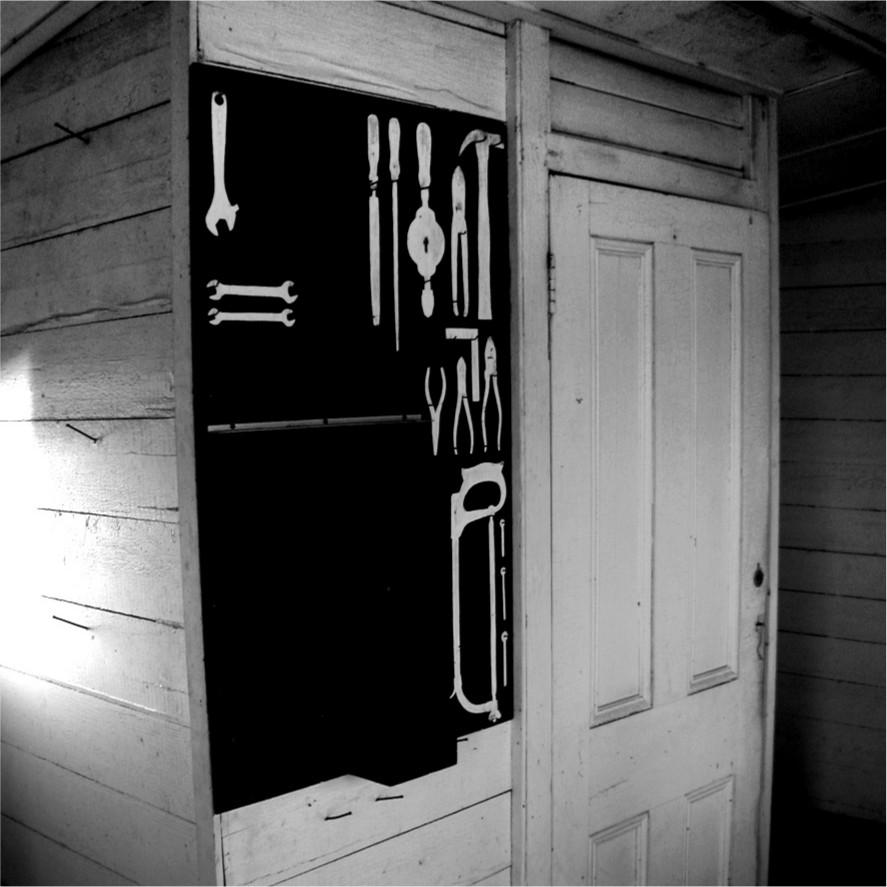
FIGURE 1
SURFACE POSITIONS OF A TOOLKIT
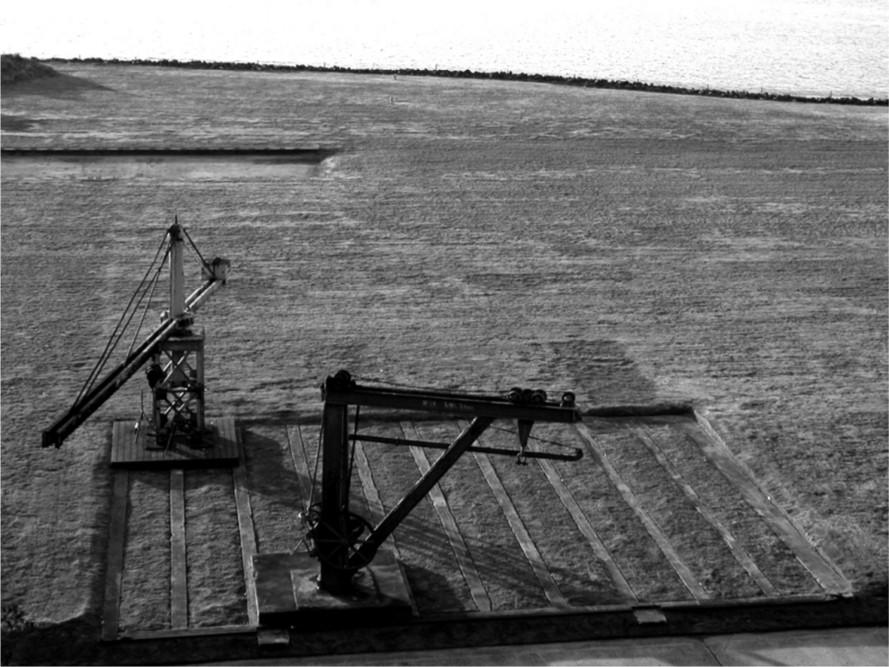
FIGURE 2
SLIPWAY NO. 2143
THINKING MATERIAL MATTERS
More intense than a merely abstract shift in program is of course a tangible shift of mass and material. A material has its own logic. A million ways exist of thinking, sensing and shaping matter.
…to cover, to wrap, to dig, to tie, to bind, to weave, to join, to match, to hinge, to mark, to expand, to dilute, to light, to modulate of mapping, of location, of context, of time to stretch, to bounce, to erase, to spray, to systematize, to refer, to force… 5
RICHARD SERRA
The topography of the island is not a stable entity. It is a sum of the forces it has been exposed to, applied to it equally by man and nature. Stones cut from the body of the island were used to reclaim land, or assembled to form buildings. The material was repositioned as officers’ quarters, prisoners’ barracks, or factory buildings. Shapes carved into the rock became shipyards; cavities were used as grain silos. A substantial amount of stone has been dislocated from its original position (Figure 3). The island exists thus with the same mass of material, but in varying degrees of density and intensification. Each stone might be traced back to its original strata. A definition of genius loci on the island is thus not the place itself, but a variety of processes that shaped it and continue to do so.
Rarely as apparent as they are on the island are two principle categories of constructive processes. The opposites of carving in and building up are present in architectural objects and ground conditions as the typologies of shelter and burrow. They describe contrasting approaches to and material conceptions of architecture.
These two conceptions are not simply two methods of designing a building but spring from deep-seated ways of viewing human existence and hence from two different architectural styles… In sculptural terms, that the one is a modeller, the other a carver. To the builder or modeller, paths are interstices between volumes; to the digger they are the primary ducts, around which the supporting matter accumulates.6
RUDOLF ARNHEIM
144The shelter is primarily a visually conceived form. It is comparable to an agglomeration of spaces in an envelope, displaying an outer shape. Architecture is assembled in a specific order of construction, dependent on gravity, with modular parts, structural layers and material specification, within a given context of building up (Figure 4). These buildings reflect a particular condition and function to which they respond. In contrast, the three-dimensionality of the burrow is formed by a system of channels, rather than by shapes. It is a network of pathways, an architecture engineered by motor behaviour. Here, a sequence of movements through a material body determines interiorised spaces. The cut applied results in hidden insertions in resistant stone or in discrete passages between two points.
Equally important in both approaches is not the resulting appearance, but the physical shaping of the material itself. A material comprises a structural property, directionality, character, and truth. Its working method thus follows the material’s inner logic. Each material inherits an essence that needs to be considered and exposed in the process.7 Techniques applied to a material are not always interchangeable. The process of handling, of shaping and transforming, can either reveal its essence or destroy it. The process of making is thus a form of research, in which threshold conditions are explored. This begins with the selection of the raw material from an area of indifference. The choice establishes juxtaposition between a concept applied and the material’s dormant possibilities, as in selecting stone from a quarry. A process of shaping is an investigation in and on the material itself: written in stone, clay, aluminium sheets, leather, glass, brick, concrete, wood, and steel. In each, the departure point is a question phrased as an approximation; only then does a realm of invention become accessible. And then it is not the finite product or the result, which is the subject of research but the process, its defaults and resistances. Each material has its own tune.
Richness and multiplicity emanate from the things themselves if we observe them attentively and give them their due.8
PETER ZUMTHOR
But process is also a domain of experience, of skilled knowledge. In the process of shaping, the material, the projected object and the human body merge. Through 145 the force applied, the muscular tension, the material receives its formative impact. Ideally, a material exploration is executed with all senses. Consecutively, the body senses in architecture, through the material traces, the forces that generated it.
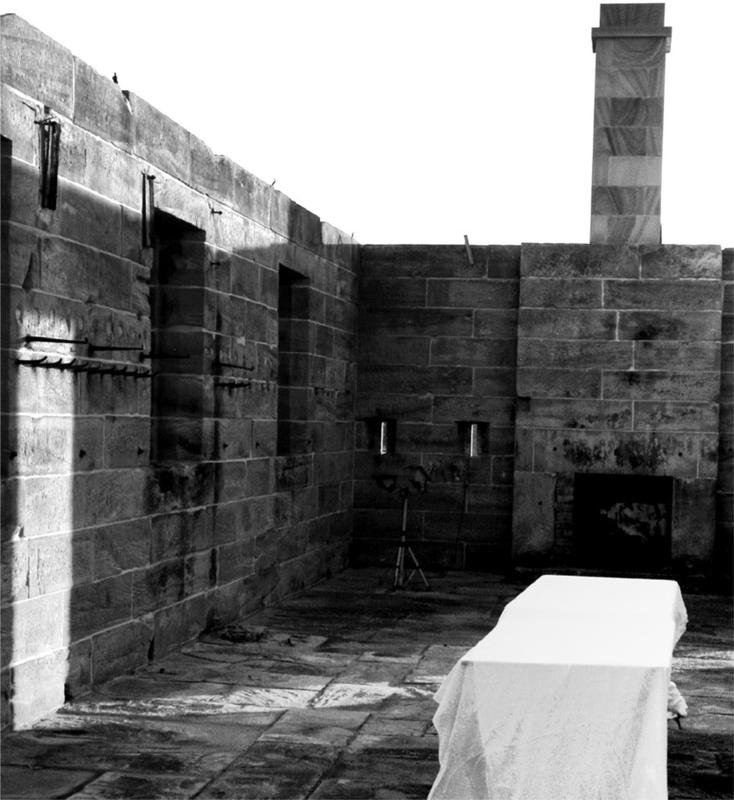
FIGURE 3
DISLOCATION OF SOLIDS / STONE STRATA
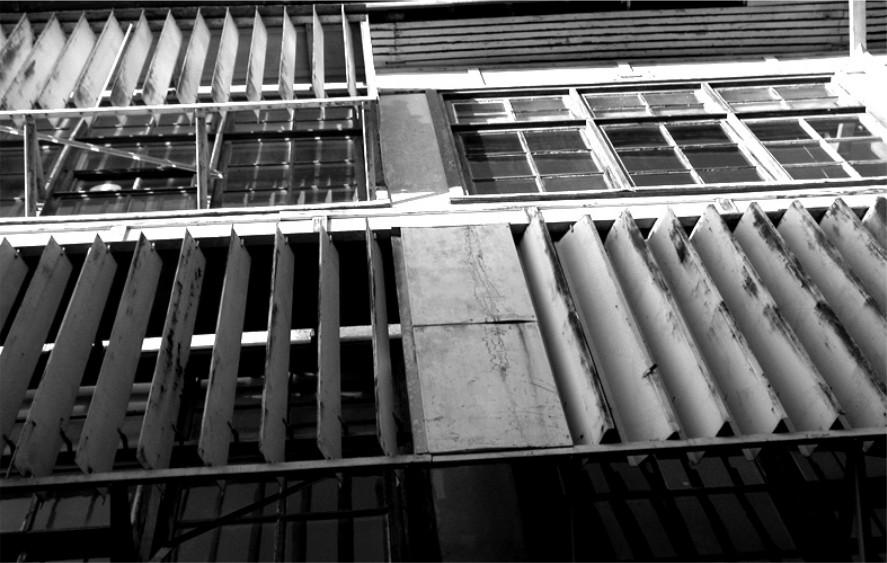
FIGURE 4
SHELTER / PATTERN STORAGE146
FATNESS AND RESONANCE
Cockatoo Island has been extensively carved to yield silos, docks, and shipyards from sandstone. It is this massiveness of stone, the solidity and thickness, the shapes and echoes of spaces inserted in the island body that have a primal, subconscious impact. The stone hides dark spaces with almost illegible boundaries lying in shadows and stained wet walls. The space inserted in stone is a fat space. In the vaulted passage to Sutherland and Fitzroy Docks (Figure 5), this fatness becomes the sound of architecture.9
The shape of the excavation enters the ear as acoustic signal. The solid sandstone reverberates with sound, transmitting echoes, amplifying small noises, tuning the distant sound of water. The fatness of the material produces a body of resonance. Space becomes an instrument.10 Its tunes originate from the surface materials that cover the walls. Stone, wood, metal reverberate in different ways. But more than that, the sound creates interiority; it reconnects body and architecture through experience and perception.
Hearing structures and articulates the experience and understanding of space. We are not normally aware of the significance of hearing in spatial experience, although sound often provides the temporal continuum in which visual impressions are embedded.11
JUHANII PALLASMA
The phenomenal appearance of the material fatness has a direct influence on the perception of both space and body. Whereas sight implies exteriority and isolates, sound incorporates. The sound rebalances between eye and ear. The observer becomes a listener, and a spatial sensation occurs. The architecture transmits meaning and dignity through a quality of experience.12147
PASSAGES OF UNBUILDING
On the island, a number of natural phenomena are in progress. Its body of sandstone was formed by sedimentations of shifting marine layers and particles, still visible as coloured strata in the stone architecture. Ground, cliff, and buildings are subject to erosion. The displacement by agents such as wind, water and ice sets free small elements of their body. These suspended, abrasive particles then traverse other material surfaces. Fragments from one material dynamically move over a surface and cause friction through which its protecting upper coat is destroyed. The force impact results in bruises, scratches, and incisions. Here, the material becomes even more penetrable. A friction in material is like a ripple running over once impeccable surfaces. Corrosion uses a timer in deterioration, a form of self-protection that is a necessary part of becoming other. A coat of rust forms, spreading particles. In all these, a material’s broken strata and layers show time passing over surfaces, the passages of unbuilding. They are not a default, an inevitable misdemeanour, but they establish a richness of reality.
A material dissolution is the unbuilding of architecture. It commences immediately on completion, and establishes a conjunction with other strata of enfolded time. Material traces pass on knowledge of transience. A material defragments, dissolves, and vanishes. A surface starts to change. It reflects traces of usage, it ages. Materials develop a patina, a crusted coat acquired in time passing, they ripen. The hue and saturation of a material’s colour deepen. Wood becomes darker. Gloss, the indicator of newness, wears off. Sometimes, different surfaces adjacent to each other seemingly undergo a process of homogenisation (Figure 6). Textures become similar. Wood turns white-grey, steel fabrics turn dark-grey, both stained equally through distribution of corrugated iron particles. Colour palettes shift. When colour coats burst and peel off, underlying layers are revealed. Iridescent facets of broken strata merge into one another, and stone shines through.
A material has a duration as well as durability. Materials define the body of architecture. This body is subject to time, and it behaves, it does not remain untouched. As much as the internal truth, structure, line of growth and 148 directionality shape the appearance of a material in construction, so they do in the process of unbuilding. There is a silent but violent movement in materials.
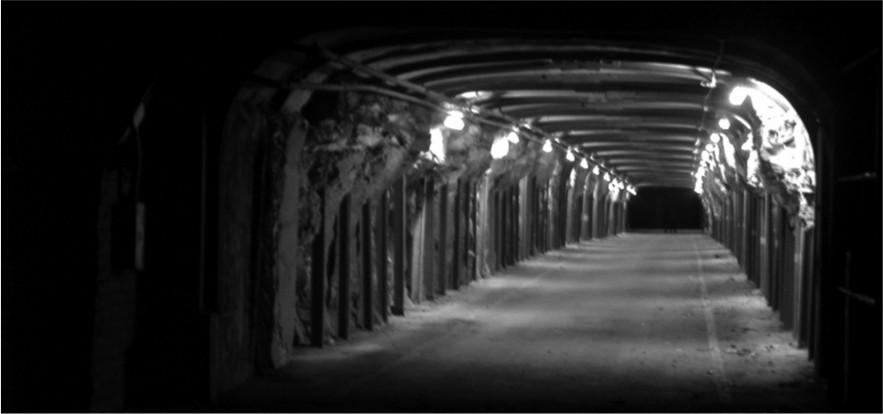
FIGURE 5
BURROW / PASSAGE TO SUTHERLAND AND FITZROY DOCKS
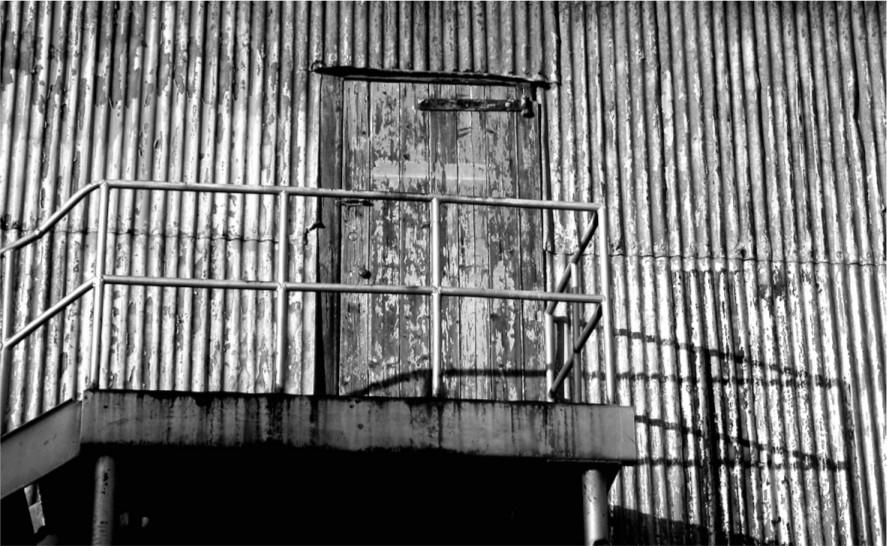
FIGURE 6
MATERIALS EQUALIZE / ESTIMATING-DRAWING OFFICES
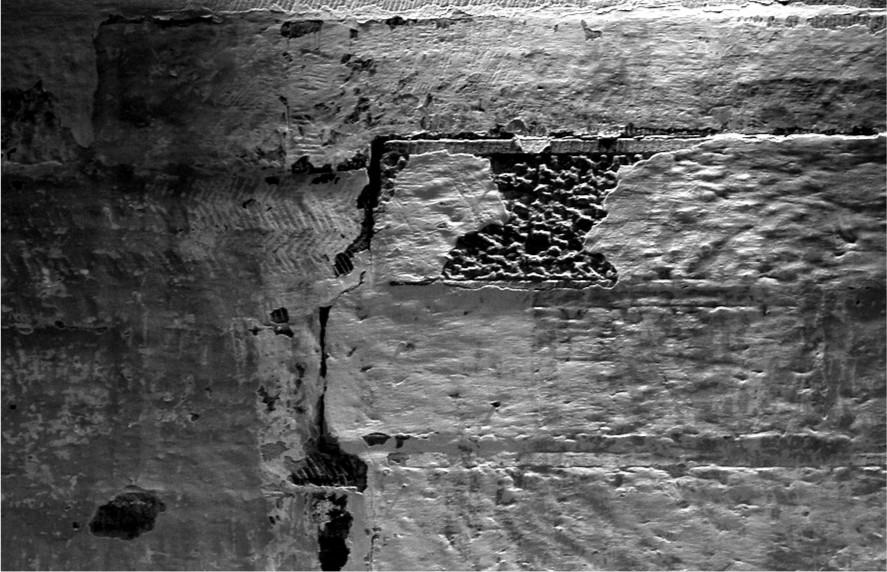
FIGURE 7
COLOUR STRATA/ MESS HALL149
Everything is approximate, less than approximate… What arrogance is concealed in perfection? Why struggle for precision, purity, when they can never be attained. The decay that begins immediately on completion of the work was now welcome to me… Dust and insects are also efficient in destruction. The light fades the colours. Sun and heat make blisters, disintegrate the paper, crack the paint, and disintegrate the paint. The dampness creates mould. The work falls apart, dies… This dissolution must have been followed by the negation of all action. Form had become uniform, the Finite the Infinite, the Individual the Whole.13
JEAN ARP
Architecture is part of a continuous process of material deterioration; structures are exposed, surfaces are dismantled, and objects become raw material. Material dissolution is part of a material’s becoming (Figure 7). It is transience, a death that rules over all things being. And it is the prospect of transience that forms the understanding of a whole. The acceptance of dissolution is the abandonment of perfection, in favour of a higher order. Material processes posses a reason of beauty, of dignity beyond perfection only visible in the process of vanishing, in the return to a different order.
A LOGIC OF BEAUTY
Materials require their own system of form. Contemporary genealogies work with an ethic of abstraction, wherein form translates as formation, driven by animation, superimposition, rotation, etc. When a discussion of aesthetics is delayed, architecture and material processes are driven by necessity rather than preference. Devoid of materiality, content or beauty, an abstract formal solution is no more than an equivalent of natural evolution. But not all evolution is the survival of the fittest. It is also the survival of the most attractive. The criterion is aesthetics.
Aesthetics, in fact, are to ethics in the sphere of conscious civilisation, what, in the sphere of the external world, sexual is to natural selection. 150Ethics, like natural selection, make existence possible. Aesthetics, like sexual selection, make life lovely and wonderful, fill it with new forms, and give it progress, and variety and change. 14
OSCAR WILDE
Beauty is the imperfect machine, the object restored to rawness, shape and material, free to receive an impact of imagination, of design. Generative processes produce forms, in computational applications and manual explorations, but neither instrument nor material ultimately generates the design. The design is done by the designer. And as each instrument is a conversion between intention and corporeality, it influences the process of thought and design.15 The result is subject to a continuation of search.
It seems that ultimately beauty is at the core. It is not a by-product, but a destination. Beauty contains an inherent formal logic, it drives a material truth. It is not necessarily perfect and not always comfortable. Most important, beauty is the correspondent of an enhancement, an uplifting experience, which gives reason and right to an object’s existence. Beauty also conveys surrender to the dynamic forces of life. The material process thus must be engineered by a research for the unforeseen, the un-projected, the unplanned, the astonishing. This requires one to relinquish control. For control of all elements establishes a situation of equilibrium, where the constituent forces compensate each other to form a homogenized area devoid of tension.16 In contrast to such homogenization, the material becoming of architecture requires to incorporate oppositional dynamics, logic and intuition, feeling and reason.17 Then, an apt material process can bring out a concentrated substance in material and architectural gestalt: the essence of an idea, which is the ‘hard core of beauty’.18 And this material process might then include the passing of time and program. The essence remains, for essence is difference; the ability of a thing to become another, the capacity for change.
The essence of Cockatoo Island is its richness - balancing sizes, materials and shapes, integrating distances, directions, curvatures, and volumes in a process of building and in the inevitable unbuilding that follows. Here, a readable interrelation of the whole and its parts, and an improbable arrangement of 151elements coexist. As discussed, when notions of age, beauty, erosion, or thickness determine the material process, this consecutively affects architecture in a number of dynamic phenomena; as frictional resistances, in becoming other, as gradual changes. Such a strategy requests an order of diversity, guided by a cognitive preference for complexity: dynamic, multi-layered, asymmetrical, and unforeseen. Through this, a continuation of genius loci as process, the retracing of traces, and a repeated conversion and recontextualisation are engendered.
Architecture, instead of communicating form, instead of representing, might just be and become other through its material processes. It then answers a demand of plenitude – a full and rich spatial experience. The island needs to submit to such logic that maintains, continues and reveals a strategy of becoming – and that incorporates the fat, the old and the beautiful.
1 Deleuze, G and Guattari, F: 2004, A Thousand Plateaus, Continuum, London, Transl. Brian Massumi. The paper uses a Deleuzian notion of ‘becoming’ as opposed to ‘being’. See also Colebrook, C: 2002, Understanding Deleuze, Allen &Unwin, Australia.
2 Sydney Harbour Federation Trust Sites – Cockatoo, History of the site. http://www.harbourtrust.gov.au/topics/sitescockatoo.html#history, (accessed 28/10/2006).
3 Miralles, E: 2000, Maps For A Cartography, El Croquis, 100/101, pp. 10-12.
4 Deleuze, G: 1003, The Fold, Continuum Books, London, transl. Tom Conley.
5 Quoting here from an exhibition display, Richard Serra: A Personal Manifesto For Making Sculpture. -
6 Arnheim, R: 1977, The Dynamics Of Architectural Form, University Of California Press, Berkeley, pp. 149-151.
7 Zumthor, P: 2006, A Way Of Looking At Things, in: Thinking Architecture, Birkhaeuser, Basel Boston Berlin, p. 10.
8 Ibid. p. .31.
9 Rasmussen, S E: 1959, Experiencing Architecture, MIT Press, Cambridge, pp. 225-226.
10 Zumthor, P: 2006, Atmospheres: Architectural Environments, Surrounding Objects, Birkhaeuser, Basel Boston Berlin, p. 29.
11 Pallasmaa, J: 1996, The Eyes of the Skin, Academy Editions, London, p. 49.
12 Alsop, W: 2001, Will Alsop Book 1, Laurence King Publishing, London, p. 171.
13 Arp, J: 1948, On My Way- Poetry And Essays 1912-1947, Wittenborn and Schultz, New York, p. 77.
14 Wilde, O: 1997, Nothing Except My Genius, Penguin Books, London, p. 35.
15 Mcluhan, M: 1964, Understanding Media, Routledge, London and New York.
16 Arnheim, R: 1971, Entropy and Art - an Essay on Disorder and Order, University of California Press, Berkeley, Los Angeles.
17 Zumthor, P: 2006, ‘A Way Of Looking At Things’, In: Thinking Architecture, Birkhaeuser, Basel Boston Berlin, p. 21.
18 Zumthor, P: 2006, ‘The Hard Core Of Beauty’, in: Thinking Architecture, Birkhaeuser, Basel Boston Berlin, p. 30.